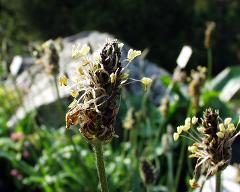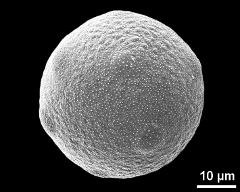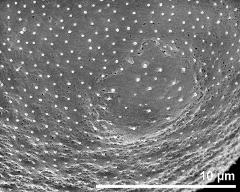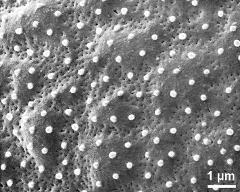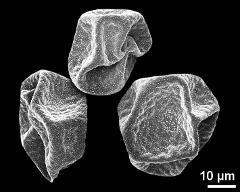Plantago atrata
Taxonomy: Angiospermae, Lamiales, Plantaginaceae, Plantago
Published: 2016-11-07
Pollen Description
Shape, Size and Aperture
pollen unit: monad, dispersal unit and peculiarities: monad, size (pollen unit): medium-sized (26-50 µm), size of hydrated pollen (LM): -, shortest polar axis in equatorial view (LM): -, longest polar axis in equatorial view (LM): -, shortest diameter in equatorial or polar view (LM): -, longest diameter in equatorial or polar view (LM): -, pollen class: porate, polarity: -, P/E-ratio: -, shape: spheroidal, outline in polar view: circular, dominant orientation (LM): -, P/E-ratio (dry pollen): -, shape (dry pollen): irregular, outline in polar view (dry pollen): irregular, infoldings (dry pollen): irregularly infolded, aperture number: >6, aperture type: porus, aperture condition: pantoporate, porate, aperture peculiarities: pantoaperturate, aperture membrane ornamented
Ornamentation and Structure
LM ornamentation LM: -, nexine: -, sexine: -, SEM ornamentation SEM: microechinate, perforate, verrucate, suprasculpture SEM: -, TEM tectum: -, infratectum: -, foot layer: -, endexine: -, intine: -, wall peculiarities: -, supratectal element: -
Miscellaneous
pollen coatings: -, reserves in cytoplasm: -, cell number: -, Ubisch bodies: -
Author(s) of diagnosis: Halbritter, Heidemarie
Pictures
Picture legend
- flower(s), photographer: Halbritter, H.
- hydrated pollen grain - fresh, rehydrated (water) & critical point dried & sputter coated with gold, photographer: Halbritter, H.
- aperture - fresh, rehydrated (water) & critical point dried & sputter coated with gold, photographer: Halbritter, H.
- exine surface - fresh, rehydrated (water) & critical point dried & sputter coated with gold, photographer: Halbritter, H.
- dry pollen grains - dry, sputter coated with gold, photographer: Halbritter, H.
Literature
- (1977) Plantaginaceae. Rev Palaeobot Palynol 24: 129-154
- (1978) Entwicklungstendenzen blütenökologischer Merkmale bei Plantago. Flora 167: 41-56
- (1976) Anthecological relations between reputedly anemophilous flowers and syrphid flies. II. Plantago media L. Acta Bot Neerl 25: 205-211
- (1978) Evolutionary aspects of wind pollination in the genus Plantago (Plantaginaceae). New Phytol 81: 449-458
- (1984) The significance of biotic pollination in a nominally anemophilous plant: Plantago lanceolata. Proc Kon Ned Akad Wet, ser C 87: 95-119
- (1976) Anthecological relations between reputedly anemophilous flowers and syrphid flies. I. The possible role of syrphid flies as pollinators of Plantago. Tijdschr Entom 119: 15-31
- (1988) Palynological study of the genus Plantago in the Iberian Peninsula. Grana 27: 1-15
- (1998) Preparing living pollen material for scanning electron microscopy using 2,2-dimethoxypropane (DMP) and criticalpoint drying. Biotechnic Histochem 73: 137–143
Copyright and Citation
Cite this publication as:
Halbritter H. 2016. Plantago atrata. In: PalDat - A palynological database. https://pc8.botanik.univie.ac.at/pub/Plantago_atrata/302035;jsessionid=571C486EF3501DD46A8518ECDB678FC9; accessed 2025-07-05

